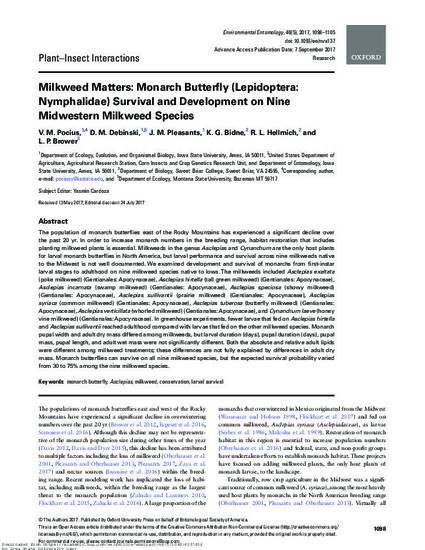
The population of monarch butterflies east of the Rocky Mountains has experienced a significant decline over the past 20 yr. In order to increase monarch numbers in the breeding range, habitat restoration that includes planting milkweed plants is essential. Milkweeds in the genus Asclepias and Cynanchum are the only host plants for larval monarch butterflies in North America, but larval performance and survival across nine milkweeds native to the Midwest is not well documented. We examined development and survival of monarchs from first-instar larval stages to adulthood on nine milkweed species native to Iowa. The milkweeds included Asclepias exaltata (poke milkweed) (Gentianales: Apocynaceae), Asclepias hirtella (tall green milkweed) (Gentianales: Apocynaceae), Asclepias incarnata (swamp milkweed) (Gentianales: Apocynaceae), Asclepias speciosa (showy milkweed) (Gentianales: Apocynaceae), Asclepias sullivantii (prairie milkweed) (Gentianales: Apocynaceae), Asclepias syriaca (common milkweed) (Gentianales: Apocynaceae), Asclepias tuberosa (butterfly milkweed) (Gentianales: Apocynaceae), Asclepias verticillata (whorled milkweed) (Gentianales: Apocynaceae), and Cynanchum laeve (honey vine milkweed) (Gentianales: Apocynaceae). In greenhouse experiments, fewer larvae that fed on Asclepias hirtella and Asclepias sullivantii reached adulthood compared with larvae that fed on the other milkweed species. Monarch pupal width and adult dry mass differed among milkweeds, but larval duration (days), pupal duration (days), pupal mass, pupal length, and adult wet mass were not significantly different. Both the absolute and relative adult lipids were different among milkweed treatments; these differences are not fully explained by differences in adult dry mass. Monarch butterflies can survive on all nine milkweed species, but the expected survival probability varied from 30 to 75% among the nine milkweed species.
Available at: http://works.bepress.com/richard_hellmich/165/

This article is published as Pocius, V. M., D. M. Debinski, J. M. Pleasants, K. G. Bidne, R. L. Hellmich, and L. P. Brower. "Milkweed Matters: Monarch Butterfly (Lepidoptera: Nymphalidae) Survival and Development on Nine Midwestern Milkweed Species." Environmental Entomology (2017). doi: 10.1093/ee/nvx137. Posted with permission.